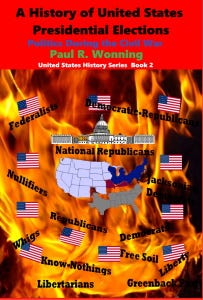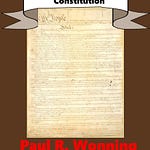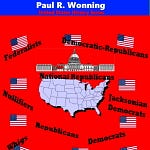Political Parties and the Presidents
Greetings, in this episode I will talk about the third book in my United States History Series. This book, entitled Political Parties and the Presidents, begins with an outline of the messy voting process that existed during the Eighteenth Century. The system was not either universal nor free from corruption. The first voting process involved a system known as “viva voce,” or voice voting. In this system the voter went to the voting place, usually the county court house or other similar public place, looked at the candidate choices and publicly declared to the county clerk, or similar official, their choices. Election day often took place in a party like atmosphere in which candidates sometimes supplied alcohol to voters in copious quantities. Paper ballots were initially printed by the various political parties and included only their candidates and excluded the names of opposing party candidates. Other forms of paper ballots appeared, all of which were subject to tampering and influencing the voter. Prior to the Civil War there was no standard election procedure and the process could vary from state to state.
The next topic involves the electoral college and the reasoning behind it. The Founders did not want to establish a democracy, contrary to many people's belief. The designed a constitutional republic with built in protections for minorities, the electoral college being one of those protections.
The book then deals with the establishment of the Republican Party and its opposition to slavery. The Republican Party wished to stop the expansion of slavery into new territories while the Democratic party espoused the practice of slavery and wanted to expand its presence. The 1856 election, in which John. C. Fremont was the first Republican Presidential Candidate faced off against James Buchanan, the Democratic candidate. It was the last election in which the Whig Party would nominate a candidate, Henry Clay. Buchanan won the election.
The 1860 election featured Abraham Lincoln as the Republican standard bearer against Democrat Stephen A. Douglas in an election that featured no fewer than 6 political parties. Excluded from most of the Southern state ballots, Lincoln carried the northeast and midwest to become the 16th President. He was immediately swept into what would become the bloodiest war the country had fought in as Southern Americans and Northern Americans clashed in what was initially a war over state's rights but evolved quickly into a fight over the practice of slavery.
The Confederacy staged one election during its short life, an election which is covered in the book. Jefferson Davis and Alexander H. Stephens received the nomination for President and Vice President respectively, and as there was no opposition to the Democratic Party, they were elected unambiguously.
The book covers the Civil War and the immediate postwar period, including the assassination of President Abraham Lincoln. The book is a must read for those wishing to learn about the politics immediately prior to and during the American Civil War.
The book is part of my United State History Series. The other two books in the series are The History of the United States Constitution and Political Parties and the A Short History of United States Politics Book. The books are available in ebook, softbound and audio book format on Amazon, Barnes and Noble, Apple and many other online book retailers.
You can find it on my web site, www.mossyfeetbooks.com.
Residents of southeast Indiana can find my books in Batesville at the Walnut Street Variety Shop on George Street
I hope you enjoyed this podcast and thank you for listening.
Greetings, in this episode I will talk about the third book in my United States History Series. This book, entitled Political Parties and the Presidents, begins with an outline of the messy voting process that existed during the Eighteenth Century. The system was not either universal nor free from corruption. The first voting process involved a system known as “viva voce,” or voice voting. In this system the voter went to the voting place, usually the county courthouse or other similar public place, looked at the candidate choices and publicly declared to the county clerk, or similar official, their choices. Election day often took place in a party like atmosphere in which candidates sometimes supplied alcohol to voters in copious quantities. Paper ballots were initially printed by the various political parties and included only their candidates and excluded the names of opposing party candidates. Other forms of paper ballots appeared, all of which were subject to tampering and influencing the voter. Prior to the Civil War there was no standard election procedure and the process could vary from state to state.
The next topic involves the electoral college and the reasoning behind it. The Founders did not want to establish a democracy, contrary to many people's belief. The designed a constitutional republic with built in protections for minorities, the electoral college being one of those protections.
The book then deals with the establishment of the Republican Party and its opposition to slavery. The Republican Party wished to stop the expansion of slavery into new territories while the Democratic party espoused the practice of slavery and wanted to expand its presence. The 1856 election, in which John. C. Fremont was the first Republican Presidential Candidate faced off against James Buchanan, the Democratic candidate. It was the last election in which the Whig Party would nominate a candidate, Henry Clay. Buchanan won the election.
The 1860 election featured Abraham Lincoln as the Republican standard bearer against Democrat Stephen A. Douglas in an election that featured no fewer than 6 political parties. Excluded from most of the Southern state ballots, Lincoln carried the northeast and midwest to become the 16th President. He was immediately swept into what would become the bloodiest war the country had fought in as Southern Americans and Northern Americans clashed in what was initially a war over state's rights but evolved quickly into a fight over the practice of slavery.
The Confederacy staged one election during its short life, an election which is covered in the book. Jefferson Davis and Alexander H. Stephens received the nomination for President and Vice President respectively, and as there was no opposition to the Democratic Party, they were elected unambiguously.
The book covers the Civil War and the immediate postwar period, including the assassination of President Abraham Lincoln. The book is a must read for those wishing to learn about the politics immediately prior to and during the American Civil War.
The book is part of my United State History Series. The other two books in the series are The History of the United States Constitution and Political Parties and the A Short History of United States Politics Book. The books are available in ebook, softbound and audio book format on Amazon, Barnes and Noble, Apple and many other online book retailers.
You can find it on my web site, www.mossyfeetbooks.com.
Residents of southeast Indiana can find my books in Batesville at the Walnut Street Variety Shop on George Street
I hope you enjoyed this podcast and thank you for listening.












Political Parties and the Presidents